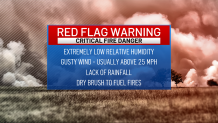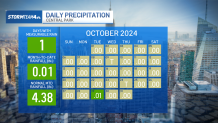The fire danger across parts of the tri-state area stands at an extreme level, prompting a red flag warning. The combination of extremely dry ground, low relative humidity and gusty wind creates the perfect environment for wildfires to start and spread quickly.
We’ve been saying it for weeks: this has been an exceptionally dry Fall. September managed only about an inch and a half of rain, with most of that coming at the tail end of the month. October was even drier, bringing weeks without a measurable drop of rain at Central Park.
An emergency burn ban has been in effect across all Connecticut state parks since Oct. 26. New Jersey is under stage 3 fire restrictions, meaning no charcoal fires are allowed and all fires in wooded areas are prohibited. Only burning with an elevated stove using propane, natural gas or electricity is allowed.


Get Tri-state area news delivered to your inbox. Sign up for NBC New York's News Headlines newsletter.
Weather Stories
Under the current extreme fire danger, no matter where you are it is best to be extra cautious and avoid any using kind of flame outside – that includes camp fires, grilling or leaf-burning. Also, be extremely cautious with cigarette ashes and butts. Dispose of them properly to avoid starting a fire.
Red flag warnings are issued when conditions conducive to fire growth reach a critical level. This is determined looking at the relative humidity, maximum wind gusts and available dry brush.
The extreme fire danger comes behind a cold front that moved through the region Friday morning, bringing much drier air into the region and significantly dropping our relative humidity – a measure of moisture content in the atmosphere. When relative humidity levels get near 30% or below, fire danger skyrockets. The drier the atmosphere, the higher the fire risk.

The cold front also kicks up the wind. Sustained winds of 10 to 20 miles per hour along with gusts up to 30 miles per hour provide more than enough movement to spread fires very quickly, making them difficult to contain.
But to get a fire started, you need kindling. Kindling for wildfires is most often dry brush, and there is an abundance of it thanks to the staggering lack of rain so far this season.
Since climate records began in 1869 in Central Park, there has never been an entire month without measurable rain. On Tuesday, 29 days into October, we finally managed to accumulate the minimum amount of measurable rain: 0.01 inches.
But that was it for the entire month. Oct. 2024 was officially the driest calendar month ever recorded, edging out the previous record of 0.02 inches, set over 75 years ago in June 1949.



This nearly bone-dry October, preceded by a relatively pitiful September, has left us with a season to date rainfall deficit over 7 inches. We have not seen a start to Autumn this dry in over 130 years (for the history buffs: Benjamin Harrison was president at the time).
And the lack of rain is taking its toll on vegetation, seen plainly in the progression of our drought conditions. At the start of September, there was no drought in our area. As of the latest update to the drought monitor on October 31, the entire state of New Jersey is now experiencing at least moderate drought conditions, with over 50% of that drought considered to be "severe."
For perspective, severe drought conditions have not exceeded 50% in New Jersey since 2002.

The exceptionally dry conditions increase the amount of available dry brush, literally contributing more fuel to our fires. This makes it easier for fires to catch and spread rapidly.
And this fire danger is only going to get worse as our rain deficit continues to grow. The rainfall outlook for the next seven days does not look promising.
Any rain that we manage get will not be enough to even begin to erase the deficit in which we’re found ourselves. Ands until our drought busting rain comes, expect our fire concerns to continue.




